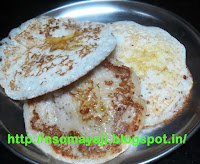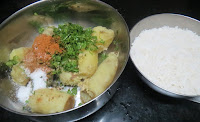Avalakki Guli appa/Paddu is a breakfast/snack dish. It is soft, fluffy and spongy. Most of us love to have them. It is normally prepared using dosa dough. Using avalakki and curd along with raw rice we do prepare dosa and idli. I just tried the same dough and prepared spicy onion coriander Guli appa.
I have used Avalakki/flattened/ Beaten Rice, curd and raw rice.
Lets know about what they call this Avalakki/Beaten or flattened rice in some indian languages.
Avalakki (in Kannada language) is known as Poha in Hindi, Pauaa /Paunva -Gurjarati and Poya in Rajastani. Chuda in Oriya, Atukulu -Telugu, Aval - Tamil and Malayalam. Pohe in Marathi and Phovu in Konkani.
Lets see some benefits of eating Avalakki/fllaten/beaten rice in our diet.
Avalakki is also known as Rice flakes is light and easy to digest. It is a good source of instant energy since it contain carbohydrates. It provides good amount of Vitamin B 1 and helps to stabalize blood sugar. It is full of iron and low on gluten.
Lets see the recipe now. We can prepare fluffy dosa, sweet/spicy and onion guliappa with the same dough.
Avalakki/Rice Flakes /Poha : 1 Cup
Raw Rice : 2 Cup
Urid dal : 1 Tablespoon
Sour Curd : 1/2 Cup
Salt : To taste
To Add :
Onions : 2
Coriander Leaves : 2 to 3 Tablespoons
Curry Leaves : 6 to 8 leaves
Green Chilly : 1
Grated ginger : 1 Teaspoon
Guli Appa / Kuli appam/ Paddu Pan
Oil : 2 to 3 Tablespoon
2. Wash and soak thin variety of Avalakki/Flatted rice separately
3. Grind rice, urid dal and avalakki using curd.
4. Remove from the mixi jar and put it in a big bowl. Add salt.
5. Mix it well and leave it for over night for fermenting. (or 6 to 8 hours)
6. Divide the ferment dough in to two parts.
7. Remove the outer skin of onions and wash it. Cut it into small.
8. Wash coriander leaves, curry leaves and green chilly. Cut them into thin pieces. Grate ginger and keep it aside. (Wash and remove the outer layer and wash it again before grating ginger).
9. Mix these cut onions, green chilly, coriander leaves to a portion of ferment dough.
10. Keep a pan on the fire. Heat. Sprinkle oil,
11. Mix the dough well and put a small portion of ground fermented dough in each part of guli appa.
12. Sprinkle oil on the top and cover. Let it cook for 1 to 2 minutes.
13. Turn the ohter side and cook for 10 Seconds.
14. Remove guli appa from the pan, add little ghee on the top and serve with the side dish you have prepared.
15. Prepare plain guli appa the same way.
Time :
Soaking time : 2 to3 Hours
Grinding : 5 to 10 minutes
Fermentation : 6 to 8 hours
Preparation of guli appa : 15 to 20 minutes
Total time : 9 Hours and 30 minutes.
You can also prepare fluffy dosas with same dough.
I have used Avalakki/flattened/ Beaten Rice, curd and raw rice.
Lets know about what they call this Avalakki/Beaten or flattened rice in some indian languages.
Avalakki (in Kannada language) is known as Poha in Hindi, Pauaa /Paunva -Gurjarati and Poya in Rajastani. Chuda in Oriya, Atukulu -Telugu, Aval - Tamil and Malayalam. Pohe in Marathi and Phovu in Konkani.
Lets see some benefits of eating Avalakki/fllaten/beaten rice in our diet.
Avalakki is also known as Rice flakes is light and easy to digest. It is a good source of instant energy since it contain carbohydrates. It provides good amount of Vitamin B 1 and helps to stabalize blood sugar. It is full of iron and low on gluten.
Lets see the recipe now. We can prepare fluffy dosa, sweet/spicy and onion guliappa with the same dough.
Things Needed :
For the doughAvalakki/Rice Flakes /Poha : 1 Cup
Raw Rice : 2 Cup
Urid dal : 1 Tablespoon
Sour Curd : 1/2 Cup
Salt : To taste
To Add :
Onions : 2
Coriander Leaves : 2 to 3 Tablespoons
Curry Leaves : 6 to 8 leaves
Green Chilly : 1
Grated ginger : 1 Teaspoon
Guli Appa / Kuli appam/ Paddu Pan
Oil : 2 to 3 Tablespoon
Method :
1. Wash and soak raw rice and urid dal together for 2 to 3 hours.2. Wash and soak thin variety of Avalakki/Flatted rice separately
3. Grind rice, urid dal and avalakki using curd.
4. Remove from the mixi jar and put it in a big bowl. Add salt.
5. Mix it well and leave it for over night for fermenting. (or 6 to 8 hours)
6. Divide the ferment dough in to two parts.
7. Remove the outer skin of onions and wash it. Cut it into small.
8. Wash coriander leaves, curry leaves and green chilly. Cut them into thin pieces. Grate ginger and keep it aside. (Wash and remove the outer layer and wash it again before grating ginger).
9. Mix these cut onions, green chilly, coriander leaves to a portion of ferment dough.
10. Keep a pan on the fire. Heat. Sprinkle oil,
11. Mix the dough well and put a small portion of ground fermented dough in each part of guli appa.
12. Sprinkle oil on the top and cover. Let it cook for 1 to 2 minutes.
13. Turn the ohter side and cook for 10 Seconds.
14. Remove guli appa from the pan, add little ghee on the top and serve with the side dish you have prepared.
15. Prepare plain guli appa the same way.
Note :
The dough must get fermented to have good guli appas. You can also add jaggery to the dough and prepare sweet guli appa or sweet dosa. Let the dough be thick while grinding .(Use curd little by little. Do not add any water while grinding).Time :
Soaking time : 2 to3 Hours
Grinding : 5 to 10 minutes
Fermentation : 6 to 8 hours
Preparation of guli appa : 15 to 20 minutes
Total time : 9 Hours and 30 minutes.
You can also prepare fluffy dosas with same dough.























































